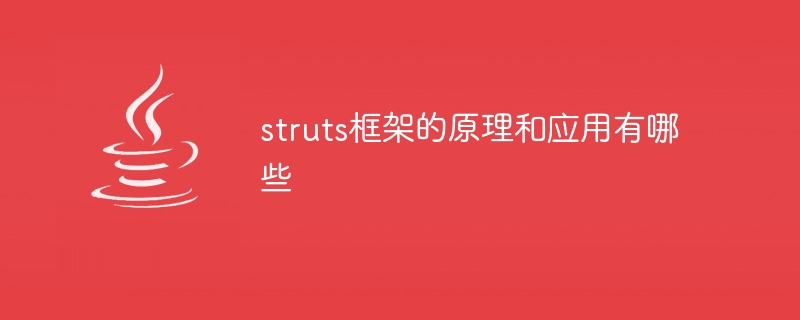Home >Java >javaTutorial >What are the principles and applications of the struts framework?
What are the principles and applications of the struts framework?
- 百草Original
- 2024-01-03 17:31:121206browse
The principle of the struts framework: By using Java Servlet/JSP technology, an application framework based on the MVC design pattern of Java EE Web applications is implemented. It uses one or more Action classes to process user requests and The results are returned to the user. Application of struts framework: 1. Build Web applications; 2. Process form data; 3. Integrate third-party libraries; 4. Implement internationalization; 5. Build RESTful API.

The operating system for this tutorial: Windows 10 system, DELL G3 computer.
The Struts framework is a Java-based Web application development framework. Its principles and applications are as follows:
1. Principle
Struts The framework implements an application framework based on the MVC design pattern of Java EE Web applications by using Java Servlet/JSP technology. It handles user requests by adopting one or more Action classes and returns the results to the user. When processing a user request, the Struts framework will forward the request to the corresponding Action class for processing, and then select the corresponding view for display based on the returned results.
The core components of the Struts framework include Struts Dispatcher and Action. Struts Dispatcher is the core controller in the Struts framework, responsible for receiving user requests and selecting the corresponding Action for processing. Action is responsible for processing user requests and returning results. It can access the model layer and view layer of the application.
In the Struts framework, users can map requests to the corresponding Action class through the configuration file (struts.xml). After processing the request, the Struts framework will return the results to the user. Users can select the corresponding view for display based on the returned results, thus realizing the separation of views and controllers in the MVC design pattern.
2. Application
The Struts framework is widely used and can help developers quickly build scalable, maintainable and testable Web applications. The following are some application scenarios of the Struts framework:
1. Building Web applications: The Struts framework is specially designed for Web applications, and it can help developers quickly build Web applications. Using the Struts framework, developers can separate the business logic and presentation layers, making applications easier to maintain and expand.
2. Processing form data: The Struts framework can help developers process form data, including validating form data, handling exceptions, etc. It provides some tag libraries and tool classes to help developers easily process form data.
3. Integrate third-party libraries: The Struts framework can be integrated with many third-party libraries, such as JQuery, Bootstrap, etc. By integrating with these libraries, developers can easily build beautiful, easy-to-use web applications.
4. Achieve internationalization: The Struts framework can help developers realize the internationalization of applications. It provides some tool classes and tag libraries that can help developers easily implement multi-language support for applications.
5. Build RESTful API: The Struts framework can help developers build RESTful API. By using the Actions and plug-ins provided by the Struts framework, developers can easily build RESTful APIs and implement functions such as CRUD operations.
In short, the Struts framework is a powerful Java Web application development framework that can help developers quickly build high-quality, scalable and maintainable Web applications. By using the Struts framework, developers can better implement the MVC design pattern and simplify the web application development process.
The above is the detailed content of What are the principles and applications of the struts framework?. For more information, please follow other related articles on the PHP Chinese website!

